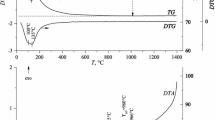The paper describes the evolution of a nanoscale powder in the cyclic heat treatment process that induces first-order phase transition. Transformation α-Fe ↔ γ-Fe in the temperature cycling range 800 ↔ 1450 K is used as an example to obtain a thermal hysteresis (temperature difference between the forward and inverse transformations). The existence of a thermodynamic hysteresis is justified in conditions when the ergodic hypothesis is not valid for nanosystems, resulting in the difference between forward and inverse transformations α-Fe ↔ γ-Fe because of the difference in their energy barriers. The thermal hysteresis is determined by the superposition of size-dependent kinetic hysteresis and size-dependent thermodynamic hysteresis. Three different cases of size dependence of the hysteresis loop width for the volume content of the new phase are identified. A potential weak size effect or zero size effect in a wide nanosize range resulting from the compensation of kinetic and thermodynamic hystereses is justified for the first time. The correlations between the size of nanopowder particles, cycling rate, and hysteresis loop width for the volume content of the new phase exhibit logarithmic dependence.





Similar content being viewed by others
References
A. S. Shirinyan and V. A. Makara, Size-Dependent Physicochemical Phenomena in Nanosized Solid Systems: Monograph [in Ukrainian], in 2 parts, Kyivsky Universytet, Kyiv (2014), p. 319.
T. Sarkar, S. Roy, J. Bhattacharya, et al., “Thermal hysteresis of some important physical properties of nanoparticles,” J. Colloid Interface Sci., 327, 224–232 (2008).
A. Atitoaie, R. Tanasa, and C. Enachescu, “Size dependent thermal hysteresis in spin crossover nanoparticles reflected within a Monte-Carlo based Ising-like model,” J. Magn. Magn. Mater., 324, 1596–1600 (2012).
T. Krenke, M. Acet, E. F. Wassermann, et al., “Martensitic transitions and the nature of ferromagnetism in the austenitic and martensitic states of NiMn–Sn alloys,” Phys. Rev. B, 72, 014412(1)–014412(9) (2005).
P. J. Shamberger and F. S. Ohuchi, “Hysteresis of the martensitic phase transition in magnetocaloric effect Ni–Mn–Sn alloys,” Phys. Rev. B, 79, 144407(1)–144407(9) (2009).
A. Neimark, P. I. Ravikovitch, and A. Vishnyakov, “Adsorption hysteresis in nanopores,” Phys. Rev. B, 65, R1493–R1496 (2002).
W. A. Jesser, R. Z. Shneck, and W. W. Gille, “Solid-liquid equilibria in nanoparticles of Pb–Bi alloys,” Phys. Rev. B, 69, 144121(1)–144121(13) (2004).
D. Michel, B. F. Borisov, E. V. Charnaya, et al., “Phase transitions for gallium microparticles in a porous glass,” Nanostruct. Mater., 12, 515–518 (1999).
V. V. Kokorin and L. E. Kozlova, “Effect of nanoparticles on structural states of martensitic phases in Fe and Cu alloys,” Nanosyst. Nanomater. Nanotekhnol., 2, No. 2, 645–673 (2004).
K. Jacobs, D. Zaziski, E. C. Scher, et al., “Activation volumes for solid–solid transformations in nanocrystals,” Science, 293, 1803–1806 (2001).
D. R. Knittel, S. P. Pack, S. H. Lin, and L. Eyring, “A thermodynamic model of hysteresis in phase transitions and its application to rare earth oxide systems,” J. Chem. Phys., 67, No. 1, 134–142 (1977).
A. S. Shirinyan and Y. S. Bilogorodskyy, “Size-induced thermal thermodynamic hysteresis in nanopowder undergoing structural transitions––from particular case to general behavior,” J. Phase Trans., 82, No. 7, 551–565 (2009).
S. S. Kiparisov, A. A. Nuzhdin, and S. V. Strelova, “Some characteristics of the reverse polymorphic transformations of sintered iron and cobalt,” Powder Metall. Met. Ceram., 23, No. 7, 546–550 (1984).
F. J. Shackelford and W. Alexander (eds.), CRC Materials Science and Engineering Handbook, 3rd ed., CRC Press LLC Inc. Boca Raton, London–New York–Washington–Florida (2001), p. 1949.
B. Ya. Lyubov, Kinetic Theory of Phase Transitions [in Russian], Metallurgiya, Moscow (1969), p. 264.
B. S. Gudkov, A. N. Subbotin, and V. I. Yakerson, “Temperature hysteresis in heterogeneous catalysis,” Priroda, No. 6, 16–21 (2001).
W. S. Lai and X. S. Zhao, “Strain-induced elastic moduli softening and associated fcc<–>bcc transition in iron,” Appl. Phys. Lett., 85, No. 19, 4340–4342 (2004).
L. H. Liang and Q. Jiang, “Size and interface effects on critical temperatures of ferromagnetic, ferroelectric and superconductive nanocrystals,” Acta Mater., 53, 3305–3311 (2005).
J. W. Christian, The Theory of Transformations in Metals and Alloys. Part 1: Equilibrium and General Kinetic Theory, Pergamon Press, Oxford (1975).
R. C. Weast, M. J. Astle, and W. H. Beyer (eds.), 1986-1987 CRC Handbook of Chemistry and Physics, 67th ed., CRC Press Inc., Florida (1987), p. 2000.
W. Matienseen and H. Warlimont (eds.), Springer Handbook of Condensed Matter and Materials Data, Springer, Berlin–Heidelberg–New York (2005), p. 1120.
L. Vitos, A. V. Ruban, H. L. Skriver, et al., “The surface energies of metals,” Surf. Sci., 411, 186–202 (1998).
G. A. Somorjai, Chemistry in Two Dimensions: Surfaces, Cornell University Press, Ithaca–London (1981), p. 570.
A. S. Shirinyan, Y. S. Bilogorodskyy, and J. W. P. Schmelzer, “Influence of nanopowder particle sizes on competition and growth of different crystallographic phases during temperature cycling,” Acta Mater., 57, 5771–5781 (2009).
Author information
Authors and Affiliations
Corresponding author
Additional information
Translated from Poroshkovaya Metallurgiya, Vol. 56, Nos. 5–6 (515), pp. 20–34, 2017.
Rights and permissions
About this article
Cite this article
Shirinyan, A.S., Bilogorodsky, Y.S. & Makara, V.A. Potential Size-Dependent Temperature Hysteresis of the First-Order Phase Transition in a Nanoscale Metallic Powder. Powder Metall Met Ceram 56, 253–263 (2017). https://doi.org/10.1007/s11106-017-9893-5
Received:
Published:
Issue Date:
DOI: https://doi.org/10.1007/s11106-017-9893-5




